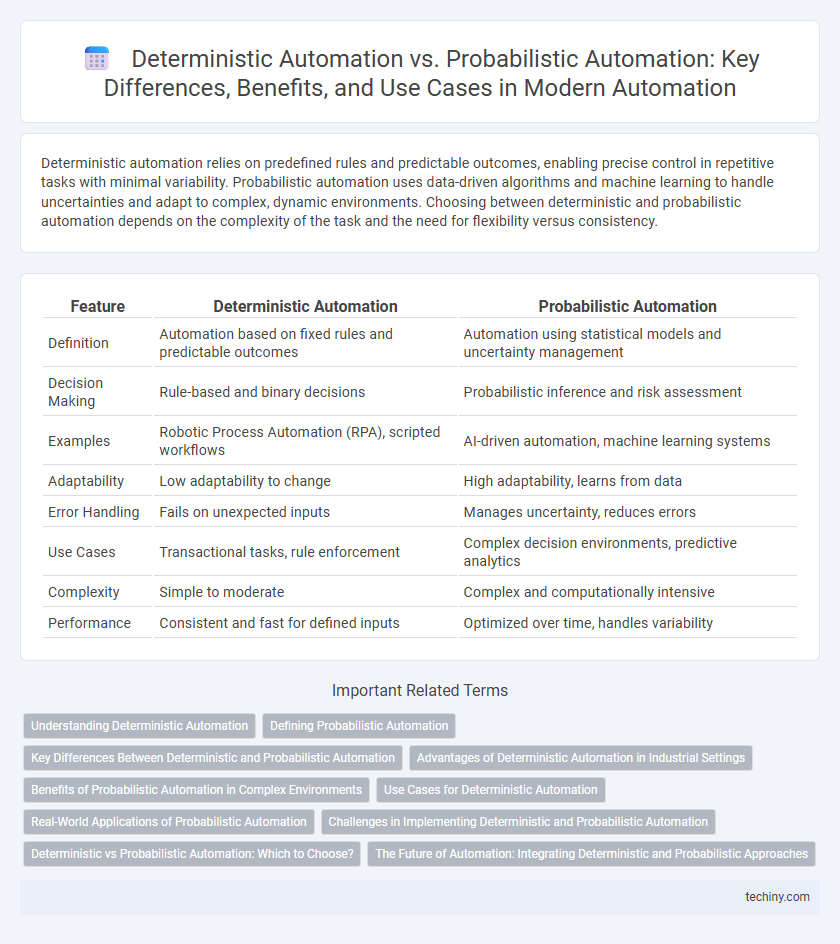Deterministic automation relies on predefined rules and predictable outcomes, enabling precise control in repetitive tasks with minimal variability. Probabilistic automation uses data-driven algorithms and machine learning to handle uncertainties and adapt to complex, dynamic environments. Choosing between deterministic and probabilistic automation depends on the complexity of the task and the need for flexibility versus consistency.
Table of Comparison
| Feature | Deterministic Automation | Probabilistic Automation |
|---|---|---|
| Definition | Automation based on fixed rules and predictable outcomes | Automation using statistical models and uncertainty management |
| Decision Making | Rule-based and binary decisions | Probabilistic inference and risk assessment |
| Examples | Robotic Process Automation (RPA), scripted workflows | AI-driven automation, machine learning systems |
| Adaptability | Low adaptability to change | High adaptability, learns from data |
| Error Handling | Fails on unexpected inputs | Manages uncertainty, reduces errors |
| Use Cases | Transactional tasks, rule enforcement | Complex decision environments, predictive analytics |
| Complexity | Simple to moderate | Complex and computationally intensive |
| Performance | Consistent and fast for defined inputs | Optimized over time, handles variability |
Understanding Deterministic Automation
Deterministic automation operates on predefined rules and fixed inputs, ensuring consistent and predictable outcomes in every execution cycle. This approach is ideal for repetitive tasks in manufacturing, data processing, and quality control where accuracy and reliability are paramount. Its reliance on explicit instructions reduces error rates and simplifies troubleshooting compared to probabilistic models.
Defining Probabilistic Automation
Probabilistic automation leverages machine learning algorithms and statistical models to handle uncertain and variable data inputs, enabling systems to make predictions and adapt to new scenarios without explicit programming. This approach contrasts with deterministic automation, which follows predefined, rule-based processes producing consistent outputs for given inputs. Probabilistic automation enhances operational flexibility by accommodating ambiguity and learning from data patterns to optimize decision-making.
Key Differences Between Deterministic and Probabilistic Automation
Deterministic automation operates on predefined rules and inputs, ensuring consistent and predictable outputs with minimal variability. Probabilistic automation leverages statistical models and machine learning to handle uncertainty, enabling systems to make decisions based on likelihoods and patterns. Key differences include the certainty of outcomes in deterministic systems versus the adaptability and risk management capabilities in probabilistic systems.
Advantages of Deterministic Automation in Industrial Settings
Deterministic automation in industrial settings offers unparalleled precision and repeatability, ensuring consistent output and minimizing errors in manufacturing processes. It enables real-time control and monitoring, leading to enhanced safety and reduced downtime by preventing unexpected variations. The predictability of deterministic systems simplifies integration with existing infrastructure, optimizing operational efficiency and scalability for complex production lines.
Benefits of Probabilistic Automation in Complex Environments
Probabilistic automation excels in complex environments by leveraging machine learning algorithms to adapt to uncertain and variable conditions, enhancing decision-making accuracy where deterministic rules may fail. Its ability to process vast datasets and predict outcomes with probabilistic models reduces errors and increases operational resilience. This flexibility enables continuous improvement in dynamic systems, making it ideal for applications such as supply chain optimization, predictive maintenance, and real-time anomaly detection.
Use Cases for Deterministic Automation
Deterministic automation excels in manufacturing assembly lines, robotic process automation (RPA) for repetitive data entry, and quality control systems where tasks follow predefined, rule-based sequences yielding predictable outcomes. It is ideal for environments requiring high precision, minimal variability, and stringent compliance with standard operating procedures. This type of automation ensures consistent performance in scenarios such as inventory management, automated testing, and regulatory reporting.
Real-World Applications of Probabilistic Automation
Probabilistic automation excels in real-world applications such as autonomous driving, where uncertainty and dynamic environments require systems to make decisions based on probabilities rather than fixed rules. In predictive maintenance, probabilistic models analyze sensor data to predict equipment failures before they occur, minimizing downtime and costs. Robotics in healthcare also benefits from probabilistic automation, enabling adaptive responses to unpredictable human interactions and varying clinical conditions.
Challenges in Implementing Deterministic and Probabilistic Automation
Challenges in implementing deterministic automation include rigid rule-based systems that struggle to adapt to complex or unforeseen scenarios, requiring precise programming and limiting scalability. Probabilistic automation faces difficulties in handling uncertainty and variability, demanding robust data quality and advanced algorithms to accurately predict outcomes. Integrating these systems often involves balancing deterministic precision with probabilistic flexibility while addressing issues like data dependency, computational complexity, and real-time decision-making constraints.
Deterministic vs Probabilistic Automation: Which to Choose?
Deterministic automation relies on predefined rules and produces consistent, repeatable outcomes ideal for structured, predictable processes, whereas probabilistic automation uses machine learning algorithms to handle uncertainty and adapt to varied data inputs. Choosing between deterministic and probabilistic automation depends on the complexity and variability of the task; deterministic systems excel in environments with stable parameters, while probabilistic models are better suited for dynamic, data-driven scenarios. Evaluating the operational context, risk tolerance, and required flexibility helps determine the optimal automation approach for maximizing efficiency and accuracy.
The Future of Automation: Integrating Deterministic and Probabilistic Approaches
The future of automation lies in the seamless integration of deterministic and probabilistic approaches, combining rule-based precision with data-driven adaptability to enhance decision-making and operational efficiency. Deterministic automation ensures consistent performance in structured environments, while probabilistic automation leverages machine learning and AI to handle uncertainty and dynamic conditions. This hybrid strategy drives smarter automation systems capable of evolving with real-time inputs and complex scenarios across industries like manufacturing, logistics, and finance.
Deterministic Automation vs Probabilistic Automation Infographic

 techiny.com
techiny.com